By Alessia Benelli
It was the birthplace of Gastone Nencini and the entire territory is crossed by cycle paths and walkable paths.
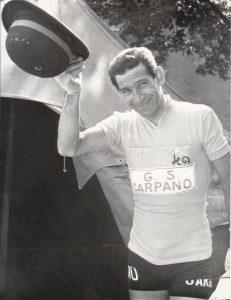
“Good is done, but it is not said. And certain medals hang on the soul, not on the jacket “. It is a famous motto of Italian cycling champion Gino Bartali, who became ‘Righteous among the Nations’ after his death – since only then this incredible story was discovered. Gino Bartali in addition to having avoided a civil war in Italy in 1948 (his victory in the Tour de France made that year’s political elections be held in a more serene atmosphere), in 1943 through 1944 he helped to save from the Holcaust more than 800 Jews, between Tuscany and Umbria.
Bartali hid false documents in the barrel of his bicycle that he was carrying from Florence to Assisi. The cycling champion collaborated with the cardinal of Florence Elia Dalla Costa who had created a printing house to falsify identity cards and save Jews from deportations. ‘Ginettaccio’ with the excuse of training and thanks to his fame, was able to pass the controls of the Nazi-Fascist army. In a year and a half he made more than 40 trips (over 200 km) between Florence and Assisi.
But what does Mugello have to do with Bartali? It fits, and how. Not everyone knows that he had family members here, precisely in Farneto on the hills of Vicchio; and Gino often came to visit them by bicycle. He left from Ponte a Ema and arrived in Mugello, spent time with his cousins, ate some tagliatelle and then returned back to Florence.
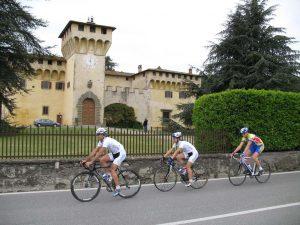 But the real father of Mugello cycling is undoubtedly Gastone Nencini: nicknamed ‘Mystery’ – the origin of this nickname is unknown – or the ‘Lion of Mugello’. It was born in 1930 in Barberino di Mugello, in what used to be the village of Bilancino – which no longer exists because the artificial lake of the same name has taken its place. He was the winner of the Giro d’Italia in 1957 at a record average (37.486 km / h) which had remained undefeated for twenty-six years, and of the Tour de France three years later. In 1957 he came close to the great feat of winning both the Giro and the Tour in the same year.
But the real father of Mugello cycling is undoubtedly Gastone Nencini: nicknamed ‘Mystery’ – the origin of this nickname is unknown – or the ‘Lion of Mugello’. It was born in 1930 in Barberino di Mugello, in what used to be the village of Bilancino – which no longer exists because the artificial lake of the same name has taken its place. He was the winner of the Giro d’Italia in 1957 at a record average (37.486 km / h) which had remained undefeated for twenty-six years, and of the Tour de France three years later. In 1957 he came close to the great feat of winning both the Giro and the Tour in the same year.
In his honour there is a monument at the Futa pass – in the Municipality of Barberino di Mugello -: along the partition wall there is a large bronze bas-relief portrait depicting him running. In 2020, on the occasion of the sixtieth anniversary of his victory at the Tour de France, Florence named a square after him: Piazza Gastone Nencini.
The entire territory of Mugello is crossed by cycle paths suitable for different needs. For those who are not too familiar with this sport and also for the little ones, we recommend the eco-tourist track along the Sieve river. The route goes from San Piero a Sieve to the town of Ponte a Vicchio and runs along the entire embankment of the tributary of the Arno. It is about 11 and a half kilometers long. We recommend starting from Borgo San Lorenzo and choosing whether to go towards San Piero a Sieve, taking a short and very easy route of a few kilometers, or going towards Vicchio, an itinerary that involves a few more kilometers of pedaling.
The Union of Municipalities of Mugello recommends five itineraries that have a different difficulty level and range: from 37 to almost 140 kilometers.
An itinerary of great landscape value is ‘Up and down the Mugello’. It records a total of 37.4 kilometers and is suitable for a cycle excursionist with a minimum of training. Departing from Borgo San Lorenzo, it allows you to admire valuable historical and architectural works such as the convent of Bosco ai Frati, the Romanesque church of Sant’Agata and the beautiful Palazzo dei Vicari di Scarperia.
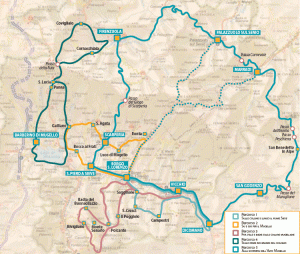
Instead, ‘On the hills and along the Sieve River’ is a path about 40 kilometers long with a moderate elevation gain, allowing you to admire the hills between Borgo San Lorenzo and Dicomano.
An itinerary suitable for expert cyclists is ‘Between villas and abbeys in the Mugello hills’: 54.4 kilometers long, the route is of medium difficulty, not so much for the overall length of the climbs, which also leave ample space for recovery, as for the particular stretch of the Salaiole climb.
‘In the footsteps of cycling greats’ is also not too long (just over 66 kilometers) but requires adequate physical preparation as it involves a double climb of the Futa Pass.
Finally, ‘Discovering the Upper Mugello’ requires considerable preparation and training due to its length and difficulty. Alternatively, the same tour can be done in two or three stages, staying overnight in the frequent hotels, farmhouses (agriturismo), residences or campsites in the area, thus favouring the visit and the naturalistic aspects. There are six climbs for a total difference in height of over 2,500 meters.
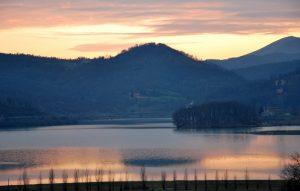
The Granfondo del Mugello Permanent Path– Every cyclist or anyone who is familiar with the bicycle and wants to ride in suggestive places, can cover the 120 kilometers of the Mugello Granfondo and obtain the patent or certificate of participation.
It is possible to participate either as members of a sports club belonging to a sports promotion body or cycling federation or independently. In the latter case, you can print the road map of the Granfondo at the link below (https://www.mugellotoscana.it/images/GRANFONDO_DEF_WEB_versione_super_finale_x_web.pdf) and pay the registration at the end of the route. If, on the other hand, you are registered with a cycling club or federation, you must register on the website www.endu.net.
Once you have the road map available, you will have to show it at each stage in order to get your stamps done. At the end of the Granfondo you will receive a gadget / souvenir.
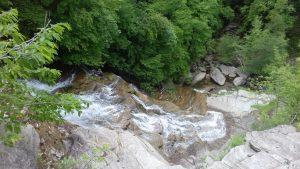
Where to refresh in Mugello – The summer heat does not spare the green hills of Mugello either. There are several places where you can cool off and, why not, take a bath.
Obviously, Lake Bilancino, one of the largest artificial lakes in Europe, is an ideal location in which to find some refreshment. Easily accessible from the A1 motorway, it offers every type of service: bar, restaurant, umbrella and sun lounger rental, skates, sailing trips …
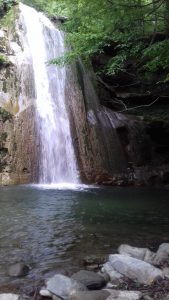 If you are interested in a more peaceful environment, we recommend the so-called ‘Pozze del Lamone’, a river in the Marradi area. In the surroundings of the town of Crespino del Lamone – in Alto Mugello -, also known as the town of good water and fountains and where there is the train station, there are some of the best known pools of water, which are easily identified, thanks to the cars parked along the roadside. Among the easiest to reach is the Valbura waterfalls which are located near the old furnace of Valbura, now disused, along the SR 302 state road or via Faentina.
If you are interested in a more peaceful environment, we recommend the so-called ‘Pozze del Lamone’, a river in the Marradi area. In the surroundings of the town of Crespino del Lamone – in Alto Mugello -, also known as the town of good water and fountains and where there is the train station, there are some of the best known pools of water, which are easily identified, thanks to the cars parked along the roadside. Among the easiest to reach is the Valbura waterfalls which are located near the old furnace of Valbura, now disused, along the SR 302 state road or via Faentina.
An almost enchanted place is on the border with Emilia Romagna and can be easily reached by car or motorbike, after crossing the Giogo Pass and its 882 meters above sea level. Here, in the heart of the Tuscan-Romagna Apennines, the ancient Vallombrosan Abbey of Moscheta was founded by San Giovanni Gualberto shortly after the year 1000, now home to the Museum of the Historical Landscape of the Apennines, among other things.
A place also suitable for families with small children and from which trails of various types and difficulties start, observing fallow deer and roe deer, and where with a little luck you can see the traces of the wolf. In Badia di Moscheta there is a typical Tuscan restaurant, appreciated for its homemade pasta and ‘tortelli’, as well as for the Florentine steak and there is also a riding school, where you can organize a suggestive guided horseback excursion at night.
